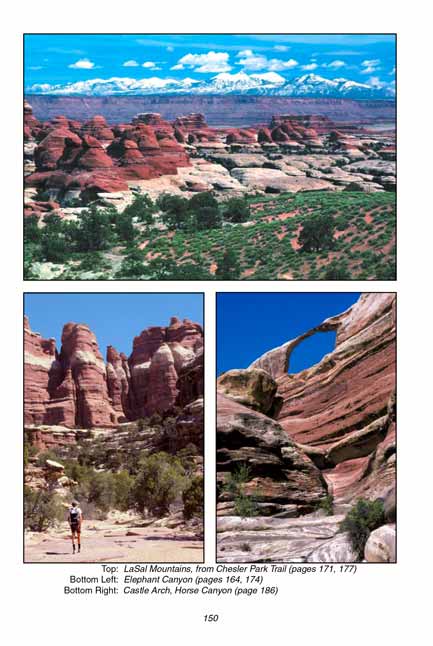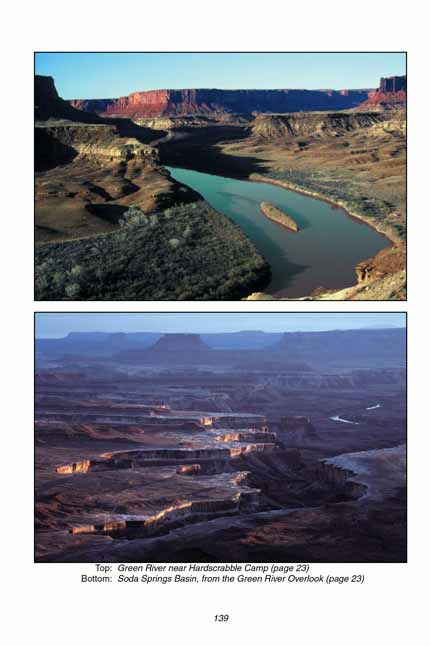Big Spring Elephant Canyon
excerpted from our book
Canyonlands National Park
Favorite Jeep Roads & Hiking Trails
pages 164-167
|
Buy book directly from the author!
Canyonlands National Park
Favorite Jeep Roads & Hiking Trails
- has access info for 75 trailheads
- 56 detailed trail maps
- 241 photographs
- loads of driving and hiking tips
|
regularly $14.95
now on sale for only
$11.95
click here
for book orders
|



 There are at least three nice loop hikes beginning at the Squaw Flat Trailhead.
Each has its own rewards, but if I had to choose a favorite I think I would name the one described here as the best of the three.
The Big Spring Canyon / Elephant Canyon trail passes through three major canyons and several minor ones where a half-dozen springs make water available for most of the year.
Numerous outcroppings of huge sandstone needles, banded with streaks of red and white, make the rugged terrain extremely attractive, and,
as the map suggests, several interesting side trips are possible if you wish to extend the length of the hike.
There are at least three nice loop hikes beginning at the Squaw Flat Trailhead.
Each has its own rewards, but if I had to choose a favorite I think I would name the one described here as the best of the three.
The Big Spring Canyon / Elephant Canyon trail passes through three major canyons and several minor ones where a half-dozen springs make water available for most of the year.
Numerous outcroppings of huge sandstone needles, banded with streaks of red and white, make the rugged terrain extremely attractive, and,
as the map suggests, several interesting side trips are possible if you wish to extend the length of the hike.
There are numerous points of interest along this trail, but the two-mile section from Squaw Canyon to the top of Big Spring Canyon is particularly exciting.
This area is a fantasyland of slickrock.
Like a giant outdoor funhouse, it has steep wavelike slides, spiraling redrock slot canyons, and several ladders bolted into the rock to help you up ledges and down dropoffs.
In short, this hike is not only incredibly scenic, it is also a lot of fun.
Begin by walking south from the Squaw Flat Trailhead, then bear right at the first junction 150 feet from the trailhead.
After another ten minutes you will see another trail coming in on the right from Squaw Flat Campground “B”.
Bear left here following the signs to Big Spring Canyon. Finally, at a distance of 1.2 miles from the road, the trail dips down to cross Big Spring Canyon.
The canyon is little more than a shallow desert ravine at this point, although there is a spring nearby and the streambed often contains water.
You will also encounter another trail junction in the bottom of the ravine, where you must bear right.
The trail on the left is the one you will use on the second half of this hike to complete the loop from Elephant Canyon back to the trailhead.
 The first 3.5 miles of this hike are across relatively flat, open desert,
but upon leaving Big Spring Canyon the terrain begins to acquire a more rugged character, dipping in and out of small arroyos and crossing frequent outcroppings of sandstone.
About 40 minutes after leaving Big Spring Canyon you will come to a large pool of water in a shady spot beside the trail.
Listen carefully and you can hear water gurgling into it from a hidden spring under the surrounding rocks.
This is the largest spring you will see on the hike.
Finally the route converges with the Chesler Park Trail coming in from the Elephant Hill Trailhead, and soon afterward it drops into the bottom of Elephant Canyon.
You will be hiking through canyons now for most of the remainder of the hike.
The first 3.5 miles of this hike are across relatively flat, open desert,
but upon leaving Big Spring Canyon the terrain begins to acquire a more rugged character, dipping in and out of small arroyos and crossing frequent outcroppings of sandstone.
About 40 minutes after leaving Big Spring Canyon you will come to a large pool of water in a shady spot beside the trail.
Listen carefully and you can hear water gurgling into it from a hidden spring under the surrounding rocks.
This is the largest spring you will see on the hike.
Finally the route converges with the Chesler Park Trail coming in from the Elephant Hill Trailhead, and soon afterward it drops into the bottom of Elephant Canyon.
You will be hiking through canyons now for most of the remainder of the hike.
After dropping into Elephant Canyon the trail turns left into the sandy streambed and continues in a southerly direction for the next 1.0 mile.
Stay in the canyon bottom as you walk past the junction with the Chesler Park Trail, then, 20 minutes later you will come to another junction where you must turn left into a smaller side canyon.
This unnamed canyon provides a route to the rim above Squaw Canyon where, in my opinion, the best part of the hike begins.
After 1.0 mile the trail climbs out the left side of the unnamed canyon and makes its way to the top of the ridge separating it from Squaw Canyon.
The trail gets steeper and steeper as it approaches the ridge, ultimately reaching a point where a ladder becomes necessary to get up the last 10 feet.
The route then crosses the top of the slickrock ridge and, with the help of another steel ladder, drops down the other side to a bench above Squaw Canyon.
The cairned trail never actually enters Squaw Canyon, but continues along the bench above its west side for 0.6 mile to the Squaw Canyon/Big Spring Canyon trail junction.
Here you must turn left and climb up over another long sloping ridge of slickrock to get into Big Spring Canyon.
The climb is steep but not difficult, and once the trail reaches the top of the ridge it immediately plunges down the other side across another smooth, unfractured surface of weathered sandstone.
There is a certain beauty in the gently curving surface of the white and pink stone. It contains no abrupt angles and no straight lines-only smooth curves.
The scene reminds me of a three dimensional graph of some complex differential equation.
After a long tortuous route downward over the slickrock the trail finally reaches the bottom of Big Spring Canyon and then proceeds to work its way northward to the beginning of the loop.
You will recognize the junction where the trail finally leaves the Big Spring / Elephant canyon. From there you can retrace your footsteps the last 1.2 miles back to the trailhead.
Note to web developers: You may copy this material onto your site, but in return please include a link to my home page
www.utahtrails.com. Thank you, David Day (utahdavidday at gmail.com)
Click here to see more trails in
Canyonlands National Park
© Rincon Publishing Company, all rights reserved
|



 There are at least three nice loop hikes beginning at the Squaw Flat Trailhead.
Each has its own rewards, but if I had to choose a favorite I think I would name the one described here as the best of the three.
The Big Spring Canyon / Elephant Canyon trail passes through three major canyons and several minor ones where a half-dozen springs make water available for most of the year.
Numerous outcroppings of huge sandstone needles, banded with streaks of red and white, make the rugged terrain extremely attractive, and,
as the map suggests, several interesting side trips are possible if you wish to extend the length of the hike.
There are at least three nice loop hikes beginning at the Squaw Flat Trailhead.
Each has its own rewards, but if I had to choose a favorite I think I would name the one described here as the best of the three.
The Big Spring Canyon / Elephant Canyon trail passes through three major canyons and several minor ones where a half-dozen springs make water available for most of the year.
Numerous outcroppings of huge sandstone needles, banded with streaks of red and white, make the rugged terrain extremely attractive, and,
as the map suggests, several interesting side trips are possible if you wish to extend the length of the hike.
 The first 3.5 miles of this hike are across relatively flat, open desert,
but upon leaving Big Spring Canyon the terrain begins to acquire a more rugged character, dipping in and out of small arroyos and crossing frequent outcroppings of sandstone.
About 40 minutes after leaving Big Spring Canyon you will come to a large pool of water in a shady spot beside the trail.
Listen carefully and you can hear water gurgling into it from a hidden spring under the surrounding rocks.
This is the largest spring you will see on the hike.
Finally the route converges with the Chesler Park Trail coming in from the Elephant Hill Trailhead, and soon afterward it drops into the bottom of Elephant Canyon.
You will be hiking through canyons now for most of the remainder of the hike.
The first 3.5 miles of this hike are across relatively flat, open desert,
but upon leaving Big Spring Canyon the terrain begins to acquire a more rugged character, dipping in and out of small arroyos and crossing frequent outcroppings of sandstone.
About 40 minutes after leaving Big Spring Canyon you will come to a large pool of water in a shady spot beside the trail.
Listen carefully and you can hear water gurgling into it from a hidden spring under the surrounding rocks.
This is the largest spring you will see on the hike.
Finally the route converges with the Chesler Park Trail coming in from the Elephant Hill Trailhead, and soon afterward it drops into the bottom of Elephant Canyon.
You will be hiking through canyons now for most of the remainder of the hike.